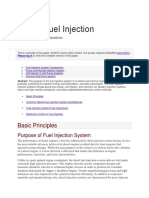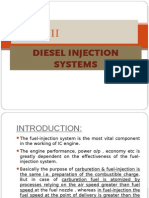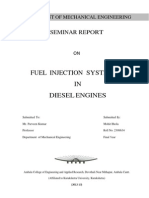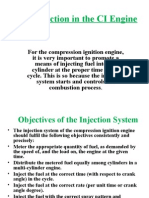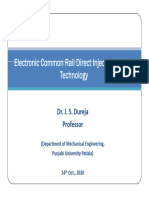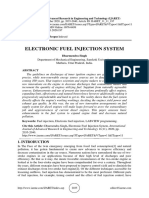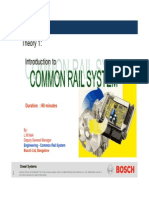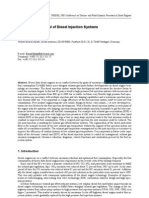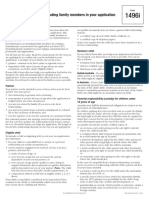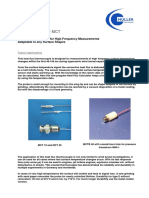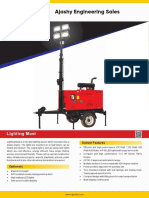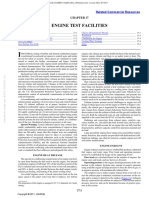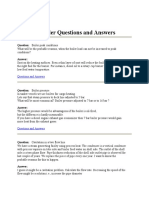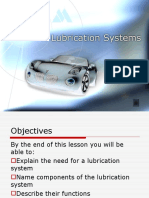0 ratings0% found this document useful (0 votes) 220 views5 pagesDiesel Fuel Injection
Copyright
© © All Rights Reserved
We take content rights seriously. If you suspect this is your content,
claim it here.
Available Formats
Download as PDF or read online on Scribd
airaizo18 Diesel Fuel injection
DieselNet.com, Copyright © Ecopoint Inc. Revision 2013.11
Diesel Fuel Injection
Magdi K. Khair, Hannu Jaaskelainen
This is a preview of the paper, limited to some initial content. Full access
requires DieselNet subscription.
Please log in to view the complete version of this paper.
Abstract: The purpose of the fuel injection system is to deliver fuel into the engine cylinders, while precisely
controlling the injection timing, fuel atomization, and other parameters. The main types of injection systems
include pump-ine-nozzle, unit injector, and common rail. Modem injection systems reach very high injection,
Pressures, and utilize sophisticated electronic control methods.
Basic Principles
‘Common Diesel Fuel Injection System Architectures
Euel Injection System/Fuel Interactions
Electronic Control in Fuel Injection
1. Basic Principles
1.1 Purpose of Fuel Injection System
The performance of diesel engines is heavily influenced by their injection system design. In fact, the
most notable advances achieved in diesel engines resulted directly from superior fuel injection system
designs. While the main purpose of the system is to deliver fuel to the cylinders of a diesel engine, itis
how that fuel is delivered that makes the difference in engine performance, emissions, and noise
characteristics.
Unlike its spark-ignited engine counterpart, the diesel fuel injection system delivers fuel under
extremely high injection pressures. This implies that the system component designs and materials
should be selected to withstand higher stresses in order to perform for extended durations that match the
engine’s durability targets, Greater manufacturing precision and tight tolerances are also required for
the system to function efficiently. In addition to expensive materials and manufacturing costs, diesel
injection systems are characterized by more intricate control requirements. All these features add up to
a system whose cost may represent as much as 30% of the total cost of the engine
The main purpose of the fuel injection system is to deliver fuel into the cylinders of an engine. In order
for the engine to effectively make use of this fuel:
i, Fuel must be injected at the proper time, that is, the injection timing must be controlled and
hitpsslmwn.deselnet comfechidiesel_fiphp us�rare Diesel Fuel nection
ii, The correct amount of fuel must be delivered to meet power requirement, that is, injection
metering must be controlled,
However, itis still not enough to deliver an accurately metered amount of fuel at the proper time to
achieve good combustion. Additional aspects are critical to ensure proper fuel injection system
performance including
‘+ Fuel atomization—ensuting that fuel atomizes into very small fuel particles is a primary design
objective for diesel fuel injection systems. Small droplets ensure that all the fuel has a chance to
vaporize and participate in the combustion process. Any remaining liquid droplets burn very
poorly or are exhausted out of the engine. While modem fuel injection systems are able to
produce fuel atomization characteristics far exceeding what is needed to ensure complete fuel
evaporation during most of the injection process, some injection s:
em designs may have poor
atomization during some brief but critical periods of the injection phase. The end of the injection
process is one such critical period.
* Bulk mixing—While fucl atomization and complete evaporation of fuel is critical, ensuring that
the evaporated fuel has sufficient oxygen during the combustion process is equally as important
to ensure high combustion efficiency and optimum engine performance, The oxygen is provided
by the intake air trapped in the cylinder and a sufficient amount must be entrained into the fuel jet
to completely mixed with the available fuel during the injection process and ensure complete
combustion.
+ Air wtilization—Eftective utilization of the air in the combustion chamber is closely tied to bulk
mixing and can be accomplished through a combination of fuel penetration into the dense air that
is compressed in the cylinder and dividing the total injected fuel into a number of jets. A
sufficient number of jets should be provided to entrain as much of available air as possible while
avoiding jet overlap and the production of fuel rich zones that are oxygen deficient.
The primary purposes of the diesel fuel injection system are graphically represented in Figure 1
Fuel Injection System
tH
Injection ‘Atomization, Bulk Mixing Injection
Timing Control & Air Utilization Quality Control
Figure 1, Main Functions of Diesel Fuel Injection System
1.2 Definition of Terms
Many specialized concepts and terms are used to describe the components and the operation of diesel
fuel injection systems. Some of the more common of these include [Brcitbach 2002][Losch 2004);
Nozzle refers to the part of the nozzle body/needle assembly which interfaces with the
combustion chamber of the engine. Terms like P-Type, M-Type, or S-Type nozzle refer to
standardized dimensions of nozzle parameters, as per ISO specifications.
hitpsslmwn.deselnet comfechidiesel_fiphp 25�airaizo18
Diesel Fuel injection
Nozzle holder or injeetor body refers to the part the nozzle is mounted on, In
conventional injection systems this part mainly served the nozzle mounting and nozzle
needle spring preloading function, In common rail systems, it contains the main functional
par
: the servo-hydraulic cireuit and the hydraulic actuator (electromagnetic or
piezoelectric).
Injector commonly refers to the nozzle holder and nozzle assembly.
Start of injection (SOL) or injection timing is the time at which injection of fuel into the
combustion chamber begins. It is usually expressed in crank angle degrees (CAD) relative
to TDC of the compression stroke. In some cases, it is important to differentiate between
the indicated SO1 and actual SOI. SO1 is often indicated by an easily measured parameter
such as the time that an electronic trigger is sent to the injector or a signal from a needle lift
sensor that indicates when the injector needle valve starts to open. The point in the cycle
where this occurs is the indicated SOI. Due to the mechanical response of the injector,
there can be a delay between the indicated SOI and the actual SOL when fuel exits the
injector nozzle into the combustion chamber. The difference between the actual SOI and
indicated SOL is the injector lag.
Start of delivery. In some fuel systems, fuel injection is coordinated with the generation of
high pressure. In such systems, the start of delivery is the time when the high pressure
pump starts to deliver fuel to the injector. The difference between start of delivery and SOI
is affected by the length of time it takes for a pressure wave to travel between the pump
and injector and is influenced by the length of line between the high pressure pump and the
injector and by the speed of sound in the fuel. The difference between the start of delivery
and SOI can be referred to as injection delay.
End of injection (EOI) is the time in the cycle when fuel injection stops.
Injected fuel quantity is the amount of fuel delivered to an engine cylinder per power
stroke. It is often expressed in mm?/stroke or mg/stroke.
Injection duration is the period of time during which fuel enters the combustion chamber
from the injector. It is the difference between EOI and SOI and is related to injection
quantity.
Injection pattern. The rate of injection of fuel often varies during the injection duration
period. Figure 2 shows three common rate shapes: boot, ramp and square. Opening rate
and closing rate refers to the gradients in the rate of injection during needle nozzle opening
and closing events, respectively.
hitpsslmwn.deselnet comfechidiesel_fiphp 35

